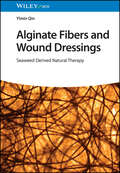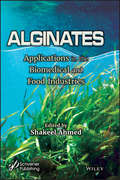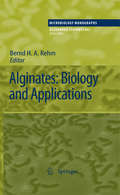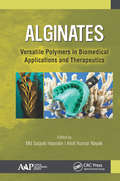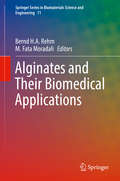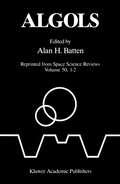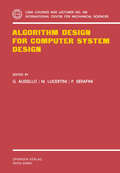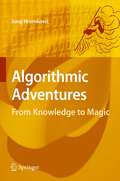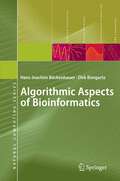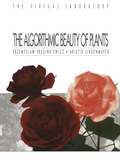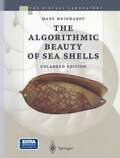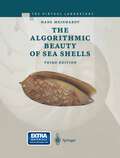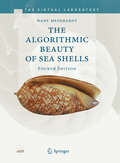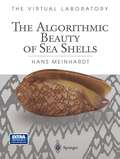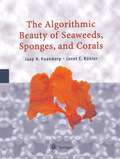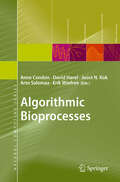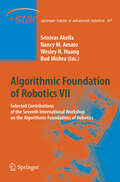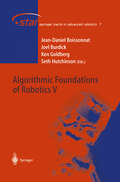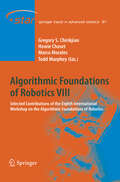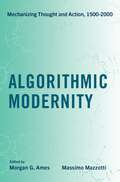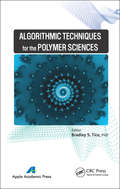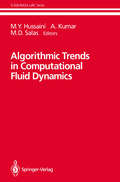- Table View
- List View
Alginate Fibers and Wound Dressings: Seaweed Derived Natural Therapy
by Yimin QinAlginate Fibers and Wound Dressings Comprehensive resource on the science and research behind alginate fibers, along with their many functional applications in different fields Alginate Fibers and Wound Dressings: Seaweed Derived Natural Therapy offers a general introduction to the sources of alginate and the production methods for alginate fibers and wound dressings, in addition to the novel properties and applications of these functional materials in wound management. Taking into consideration of the latest results of clinical researches conducted around the world, this book summarizes the unique properties of alginate wound dressings, including their ‘gel blocking’ properties and the ability to promote wound healing, facilitate haemostasis, reduce pain, suppress bacteria growth, and lower treatment cost in the treatment of a wide range of wounds, including leg ulcers, burn wounds, pressure sores, surgical wounds, and many other types of wounds with high levels of exudates. Sample topics covered in Alginate Fibers and Wound Dressings include: Why alginate fibers can be used as a carrier to deliver zinc, copper, silver, and other bioactive metal ions How alginate wound dressings can help maintain a physiologically moist microenvironment that promotes healing and the formation of granulation tissue Unique properties of alginate fibers that are highly useful for functional textile materials and medical textile products, such as gel forming properties when in contact with body fluid Other excellent performance characteristics of alginate fibers, such as haemostatic, antimicrobial, skin whitening, and many other unique bioactivities Providing comprehensive coverage of the subject, Alginate Fibers and Wound Dressings is an essential resource for students, researchers, and professionals involved in professions and programs of study that intersect with the subject.
Alginates: Applications in the Biomedical and Food Industries
by Shakeel AhmedAlginate is a hydrophilic, biocompatible, biodegradable, and relatively economical polymer generally found in marine brown algae. The modification in the alginate molecule after polymerization has shown strong potential in biomedical, pharmaceutical and biotechnology applications such as wound dressing, drug delivery, dental treatment, in cell culture and tissue engineering. Besides this, alginates have industrial applications too in the paper and food industries as plasticizers and additives. The few books that have been published on alginates focus more on their biology. This current book focuses on the exploration of alginates and their modification, characterization, derivatives, composites, hydrogels as well as the new and emerging applications.
Alginates: Applications in the Biomedical and Food Industries
by Shakeel AhmedAlginate is a hydrophilic, biocompatible, biodegradable, and relatively economical polymer generally found in marine brown algae. The modification in the alginate molecule after polymerization has shown strong potential in biomedical, pharmaceutical and biotechnology applications such as wound dressing, drug delivery, dental treatment, in cell culture and tissue engineering. Besides this, alginates have industrial applications too in the paper and food industries as plasticizers and additives. The few books that have been published on alginates focus more on their biology. This current book focuses on the exploration of alginates and their modification, characterization, derivatives, composites, hydrogels as well as the new and emerging applications.
Alginates: Biology And Applications (Microbiology Monographs #13)
by Bernd H.A. Rehm"Alginates: Biology and Applications" provides an overview of the state of art of alginate material properties, genetics and the molecular mechanisms underlying alginate biosynthesis as well as applications of tailor-made alginates in medicine, food and biotechnology. Topics treated are: material properties of alginates, alginate production: precursor biosynthesis, polymerization and secretion, bacterial system for alginate uptake and degradation, enzymatic alginate modification, alginate gene regulation, role of alginate in bacterial biofilms, microbial production of alginates: physiology and process aspects, alginate-based blends and nano/microbeads, applications of alginates in food, alginate and its comonomer mannuronic acid: medical relevance as drugs.
Alginates: Versatile Polymers in Biomedical Applications and Therapeutics
by Saquib Hasnain Amit Kumar NayakThis new volume explores the latest research on the use of alginate as a biopolymer in various biomedical applications and therapeutics. The uses of alginates and modified alginates discussed in this book include tissue regeneration, encapsulation and delivery of drugs, nucleic acid materials, proteins and peptides, genes, herbal therapeutic agents, nutraceuticals, and more. This book also describes the synthesis and characterizations of various alginate and modified alginate systems, such as hydrogels, gels, composites, nanoparticles, scaffolds, etc., used for the biomedical applications and therapeutics. Alginate, a biopolymer of natural origin, is of immense interest for its variety of applications in pharmaceuticals (as medical diagnostic aids) and in materials science. It is the one of the most abundant natural biopolymers and is considered an excellent excipient because of its non-toxic, stable, and biodegradable properties. Several research innovations have been made on applications of alginate in drug delivery and biomedicines. There needs to be a thorough understanding of the synthesis, purification, and characterization of alginates and its derivatives for their utility in healthcare fields, and this volume offers an abundance of information toward that end.
Alginates: Versatile Polymers in Biomedical Applications and Therapeutics
by Saquib Hasnain Amit Kumar NayakThis new volume explores the latest research on the use of alginate as a biopolymer in various biomedical applications and therapeutics. The uses of alginates and modified alginates discussed in this book include tissue regeneration, encapsulation and delivery of drugs, nucleic acid materials, proteins and peptides, genes, herbal therapeutic agents, nutraceuticals, and more. This book also describes the synthesis and characterizations of various alginate and modified alginate systems, such as hydrogels, gels, composites, nanoparticles, scaffolds, etc., used for the biomedical applications and therapeutics. Alginate, a biopolymer of natural origin, is of immense interest for its variety of applications in pharmaceuticals (as medical diagnostic aids) and in materials science. It is the one of the most abundant natural biopolymers and is considered an excellent excipient because of its non-toxic, stable, and biodegradable properties. Several research innovations have been made on applications of alginate in drug delivery and biomedicines. There needs to be a thorough understanding of the synthesis, purification, and characterization of alginates and its derivatives for their utility in healthcare fields, and this volume offers an abundance of information toward that end.
Alginates and Their Biomedical Applications (Springer Series in Biomaterials Science and Engineering #11)
by Bernd H.A. Rehm M. Fata MoradaliThis book presents a comprehensive review of the latest advances in developing alginate-based biomaterials and derivatives as well as their biomedical and pharmaceutical applications. It covers the physiochemical properties of alginates, production and formulation methods, derivatizations and characterization methods, the fundamental work on optimizing alginate polymers for defined biomedical purposes as well as the scope and effectiveness of their applications in medicine and therapeutic approaches. The book brings together new concepts and advances in harnessing alginate-based biomaterials in combination with applied technological advances to tailor their applications to medical needs. The contributions by leading academics, clinicians and researchers not only cover the fundamentals, but also open new avenues for meeting future challenges in research and clinical applications.
Algols: Proceedings of the 107th Colloquium of the International Astronomical Union held in Sidney, B.C., Canada, August 15–19, 1988
by A. H. BattenWhen leaving the Victoria airport the day before our Colloquium, I saw a van of the Dunsmuir Lodge marked with big letters which I read as "Alcohol Colloquium". I do often make such blunders because of the global, casual, and careless way in which I read various ads, and checked myself quickly to read it correctly as "Algol Colloquium". Millions of fellow citizens could easily make the same mistake, and no apology could be expected. Even I read and hear the word alcohol more frequently than Algol, although I must say that Algols have given me more pleasure and fewer headaches over the years; in that, however, I may be a singularity, and possibly a pitiful one at that. Being appointed Chairman of the Scientific Organizing Committee, I may be deemed to be a purer" Algolist" than other investigators, although my range of active interests is much broader; and the same is true about all the 28 invited speakers and all the other participants of the Colloquium. Our interest are strongly diversified, but there are several good reasons that brought us together at this Colloquium.
Algorithm Design for Computer System Design (CISM International Centre for Mechanical Sciences #284)
by Giorgio Ausiello M. Lucertini P. SerafiniAlgorithmic Adventures: From Knowledge to Magic
by Juraj HromkovičThe ?rst and foremost goal of this lecture series was to show the beauty, depth and usefulness of the key ideas in computer science. While working on the lecture notes, we came to understand that one can recognize the true spirit of a scienti?c discipline only by viewing its contributions in the framework of science as a whole. We present computer science here as a fundamental science that, interacting with other scienti?c disciplines, changed and changes our view on the world, that contributes to our understanding of the fundamental concepts of science and that sheds new light on and brings new meaning to several of these concepts. We show that computer science is a discipline that discovers spectacular, unexpected facts, that ?nds ways out in seemingly unsolvable s- uations, and that can do true wonders. The message of this book is that computer science is a fascinating research area with a big impact on the real world, full of spectacular ideas and great ch- lenges. It is an integral part of science and engineering with an above-average dynamic over the last 30 years and a high degree of interdisciplinarity. The goal of this book is not typical for popular science writing, whichoftenrestrictsitselftooutliningtheimportanceofaresearch area. Whenever possible we strive to bring full understanding of the concepts and results presented.
Algorithmic Aspects of Bioinformatics (Natural Computing Series)
by Hans-Joachim Böckenhauer Dirk BongartzThis book introduces some key problems in bioinformatics, discusses the models used to formally describe these problems, and analyzes the algorithmic approaches used to solve them. After introducing the basics of molecular biology and algorithmics, Part I explains string algorithms and alignments; Part II details the field of physical mapping and DNA sequencing; and Part III examines the application of algorithmics to the analysis of biological data. Exciting application examples include predicting the spatial structure of proteins, and computing haplotypes from genotype data. Figures, chapter summaries, detailed derivations, and examples, are provided.
The Algorithmic Beauty of Plants (The Virtual Laboratory)
by Przemyslaw Prusinkiewicz Aristid LindenmayerNow available in an affordable softcover edition, this classic in Springer's acclaimed Virtual Laboratory series is the first comprehensive account of the computer simulation of plant development. 150 illustrations, one third of them in colour, vividly demonstrate the spectacular results of the algorithms used to model plant shapes and developmental processes. The latest in computer-generated images allow us to look at plants growing, self-replicating, responding to external factors and even mutating, without becoming entangled in the underlying mathematical formulae involved. The authors place particular emphasis on Lindenmayer systems - a notion conceived by one of the authors, Aristid Lindenmayer, and internationally recognised for its exceptional elegance in modelling biological phenomena. Nonetheless, the two authors take great care to present a survey of alternative methods for plant modelling.
The Algorithmic Beauty of Sea Shells (The Virtual Laboratory)
by Hans MeinhardtThe pigment patterns on tropieal shells are of great beauty and diversity. They fas cinate by their mixture of regularity and irregularity. A partieular pattern seems to follow partieular mIes but these mIes allow variations. No two shells are identical. The motionless patterns appear to be static, and, indeed, they consist of calcified material. However, as will be shown in this book, the underlying mechanism that gene rates this beauty is eminently dynamic. It has much in common with other dynamie systems that generate patterns, such as a wind-sand system that forms large dunes, or rain and erosion that form complex ramified river systems. On other shells the underlying mechanism has much in common with waves such as those commonly observed in the spread of an epidemie. A mollusc can enlarge its shell only at the shell margin. In most cases, only at this margin are new elements of the pigmentation pattern added. Therefore, the shell pattern preserves arecord in time of a process that took place in a narrow zone at the growing edge. A certain point on the shell represents a certain moment in its history. Like a time machine one can go into the past or the future just by turning the shell back and forth. Having this complete historieal record opens the possibility of decoding the generic principles behind this beauty. My interest in these patterns began with a dinner in an Italian restaurant.
The Algorithmic Beauty of Sea Shells (The Virtual Laboratory)
by Hans MeinhardtThe fascinating patterns on the shells of tropical sea snails are not only compellingly beautiful but also tell a tale of biological development. The decorative patterns are records of their own genesis, which follows laws such as those of dune formation or the spread of a flu epidemic. Hans Meinhardt has analyzed the dynamical processes that form these patterns and has retraced them in computer simulations. His book is exciting not only for the astonishing scientific knowledge it reveals but also for its fascinating pictures. An accompanying CD-ROM with the corresponding algorithms allows the reader to simulate the natural pattern formation and growth processes.
The Algorithmic Beauty of Sea Shells (The Virtual Laboratory)
by Hans MeinhardtThe pigment patterns on tropical shells are of great beauty and diversity. Their mixture of regularity and irregularity is fascinating. A particular pattern seems to follow particular rules but these rules allow variations. No two shells are identical. The motionless patterns appear to be static, and, indeed, they consist of calci?ed material. However, as will be shown in this book, the underlying mechanism that generates this beauty is eminently dynamic. It has much in common with other dynamic systems that generate patterns, such as a wind-sand system that forms large dunes, or rain and erosion that form complex rami?ed river systems. On other shells the underlying mechanism has much in common with waves such as those commonly observed in the spread of an epidemic. A mollusk can only enlarge its shell at the shell margin. In most cases, only at this margin are new elements of the pigmentation pattern added. Therefore, the shell pattern preserves the record of a process that took place over time in a narrow zone at the growing edge. A certain point on the shell represents a certain moment in its history. Like a time machine one can go into the past or the future just by turning the shell back and forth. Having this complete historical record opens the possibility of decoding the generic principles behind this beauty.
The Algorithmic Beauty of Sea Shells (The Virtual Laboratory)
by Hans MeinhardtFor centuries scientists have tried to understand the growth and development of multicellular organisms. More recently, with the help of mathematical models and computerized simulations, they have discovered algorithmic patterns and models that seem to describe the dynamic processes in which organisms grow, reproduce, and respond to external factors. In this fascinating and beautifully illustrated book, Hans Meinhardt explains and illustrates these structural growth patterns in the case of sea shells. The book delightfully conveys the intuitive appeal and the "touch of magic" in this research. A diskette packaged with the book contains a program that allows the reader to run the simulations on a PC. New patterns can be generated interactively to provide an insight into the process of biological pattern formation.
The Algorithmic Beauty of Seaweeds, Sponges and Corals (The Virtual Laboratory)
by Jaap A. Kaandorp Janet E. KüblerWith contributions by E.Abraham, D.Barnes, R.Carpenter, L.Collado, P.Dodds, S.Dudgeon, D.Garbary, S.Gatti, B.Helmuth, M.R.Koehl, H.Lasker, R.Merks., W.Müller, S.Muko, B. Rinkevich, J.Sanchez, P.Sloot, M.Vermeij
Algorithmic Bioprocesses (Natural Computing Series)
by Anne Condon David Harel Joost N. Kok Arto Salomaa Erik WinfreeA fundamental understanding of algorithmic bioprocesses is key to learning how information processing occurs in nature at the cell level. The field is concerned with the interactions between computer science on the one hand and biology, chemistry, and DNA-oriented nanoscience on the other. In particular, this book offers a comprehensive overview of research into algorithmic self-assembly, RNA folding, the algorithmic foundations for biochemical reactions, and the algorithmic nature of developmental processes. The editors of the book invited 36 chapters, written by the leading researchers in this area, and their contributions include detailed tutorials on the main topics, surveys of the state of the art in research, experimental results, and discussions of specific research goals. The main subjects addressed are sequence discovery, generation, and analysis; nanoconstructions and self-assembly; membrane computing; formal models and analysis; process calculi and automata; biochemical reactions; and other topics from natural computing, including molecular evolution, regulation of gene expression, light-based computing, cellular automata, realistic modelling of biological systems, and evolutionary computing. This subject is inherently interdisciplinary, and this book will be of value to researchers in computer science and biology who study the impact of the exciting mutual interaction between our understanding of bioprocesses and our understanding of computation.
Algorithmic Foundation of Robotics VII: Selected Contributions of the Seventh International Workshop on the Algorithmic Foundations of Robotics (Springer Tracts in Advanced Robotics #47)
by Srinivas Akella Nancy M. Amato Wesley Huang Bud MishraAlgorithms are a fundamental component of robotic systems: they control or reason about motion and perception in the physical world. They receive input from noisy sensors, consider geometric and physical constraints, and operate on the world through imprecise actuators. The design and analysis of robot algorithms therefore raises a unique combination of questions in control theory, computational and differential geometry, and computer science. This book contains the proceedings from the 2006 Workshop on the Algorithmic Foundations of Robotics. This biannual workshop is a highly selective meeting of leading researchers in the field of algorithmic issues related to robotics. The 32 papers in this book span a wide variety of topics: from fundamental motion planning algorithms to applications in medicine and biology, but they have in common a foundation in the algorithmic problems of robotic systems.
Algorithmic Foundations of Robotics V (Springer Tracts in Advanced Robotics #7)
by Jean-Daniel Boissonnat Joel Burdick Ken Goldberg Seth HutchinsonSelected contributions to the Workshop WAFR 2002, held December 15-17, 2002, Nice, France. This fifth biannual Workshop on Algorithmic Foundations of Robotics focuses on algorithmic issues related to robotics and automation. The design and analysis of robot algorithms raises fundamental questions in computer science, computational geometry, mechanical modeling, operations research, control theory, and associated fields. The highly selective program highlights significant new results such as algorithmic models and complexity bounds. The validation of algorithms, design concepts, or techniques is the common thread running through this focused collection.
Algorithmic Foundations of Robotics VIII: Selected Contributions of the Eighth International Workshop on the Algorithmic Foundations of Robotics (Springer Tracts in Advanced Robotics #57)
by Gregory S. Chirikjian Howie Choset Marco Morales Todd MurpheyAlgorithmic Modernity: Mechanizing Thought and Action, 1500-2000
by Morgan G. Ames and Massimo MazzottiAlgorithms have been transforming human society long before the advent of computing. Yet they continue to exist in relative invisibility despite their presence behind many of our modern social interactions. The rhetoric of algorithmic neutrality is more alive than ever, and algorithms are often depicted as obvious and unproblematic—without context and without history. Algorithmic Modernity draws together the history of mathematics and intellectual history to convey the enduring global history of the algorithm as a computational tool, epistemic ideal, and rhetorical figure alongside the ascendance of modernity. Through historical reconstructions of relevant thinkers and cultural phenomena over the last five hundred years, this collection of essays reveals how algorithms became the standard method for solving problems from the early inclusion of algorithms in Newton's formation of calculus to their later influence in the New Deal economy. Together, these essays create an informed history for readers interested in the social and cultural implications of today's pervasive digital algorithm. Featuring experts in mathematics, history, and computing, Algorithmic Modernity presents a multi-faceted exploration of the genealogy of algorithmic thinking in modern times.
Algorithmic Modernity: Mechanizing Thought and Action, 1500-2000
Algorithms have been transforming human society long before the advent of computing. Yet they continue to exist in relative invisibility despite their presence behind many of our modern social interactions. The rhetoric of algorithmic neutrality is more alive than ever, and algorithms are often depicted as obvious and unproblematic—without context and without history. Algorithmic Modernity draws together the history of mathematics and intellectual history to convey the enduring global history of the algorithm as a computational tool, epistemic ideal, and rhetorical figure alongside the ascendance of modernity. Through historical reconstructions of relevant thinkers and cultural phenomena over the last five hundred years, this collection of essays reveals how algorithms became the standard method for solving problems from the early inclusion of algorithms in Newton's formation of calculus to their later influence in the New Deal economy. Together, these essays create an informed history for readers interested in the social and cultural implications of today's pervasive digital algorithm. Featuring experts in mathematics, history, and computing, Algorithmic Modernity presents a multi-faceted exploration of the genealogy of algorithmic thinking in modern times.
Algorithmic Techniques for the Polymer Sciences
by Bradley S. TiceThis new book-the first of its kind-examines the use of algorithmic techniques to compress random and non-random sequential strings found in chains of polymers. The book is an introduction to algorithmic complexity. Examples taken from current research in the polymer sciences are used for compression of like-natured properties as found on a chain o
